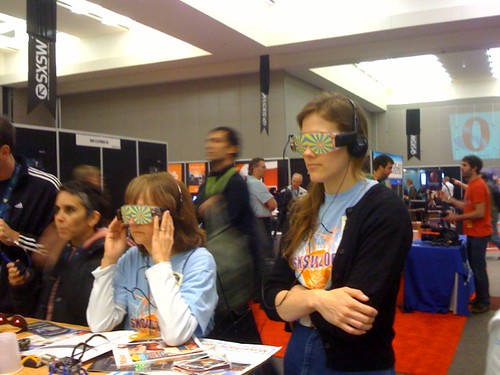
Trying to see the future of digital media.
I recently attended SXSW Interactive, a conference on new media in Austin, TX, from March 7-12. Attracting digital creatives as well as visionary technology entrepreneurs, the event celebrates the best minds and the brightest personalities of emerging technology.
Taking place on three floors of the Austin convention center, the event is overwhelming, with sessions beginning at 10 and running to 5 with bonus events and parties in the evening. There were usually about a dozen different things you could do at any time during the day. For example, at 11:30 on Saturday you could choose from panels on e-commerce, managing communities that work, Expression Engine 2.0 sneak peek, accessible rich media, the contextual web or “how to rawk SXSW and achieve geekgasm”. In addition to the panels, you could also go to book readings, take part in smaller “core conversations” on select topics, visit the trade show or pop into the ScreenBurn Gaming Fest.
The evenings featured parties and events where you could meet fellow techies. I went to the Dorkbot happy hour (geeks showing off their robots), a BikeHugger happy hour (with excellent barbecue), the SXSW Web Awards (sponsored by Adobe) and the “Rock Bands Rock Opera” party, sponsored by a company called Opera. These were excellent opportunities to drink free beer and meet other web folks from around the country.
It amazed me how tech-savvy the participants at the conference were. Nearly everyone had an iPhone, it seemed, and those who didn’t brought laptops to the conference to take advantage of the convention center’s speedy wifi service. The conference provided many handy online tools for participants. For example, I created my own calendar of events and downloaded it to my iPhone. SXSW also featured a mobile version of the conference program and a daily blog that I could read on my iPhone. I took notes on my iPhone so I didn’t need to carry paper around at all.
However, I was a Luddite compared to many people, who were updating what they were doing on Twitter and Facebook, uploading pictures to Flickr, making podcasts, and chatting about the sessions they were in in Meebo.
The overall theme of the conference was excitement over the future of the web. Participants in the conference shared an evangelical confidence in technology. This confidence was not placed in big companies but in small, organic teams, reflecting the DIY attitude of Austin and SXSW.
I’ll write more about the experience in the coming days.


